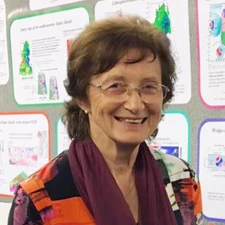Jaroslava Plomerová

The 2024 Beno Gutenberg Medal is awarded to Jaroslava Plomerová for contributions to the development of sophisticated methodologies in the characterisation of anisotropic domains in the upper mantle, and their application to imaging of the lithosphere in Europe.
Jaroslava Plomerova is one of the leading scientists in observational seismology in Europe. Her research embodies a strong combination of seismological observations and related interpretations in terms of rock physics, large-scale structures and geodynamics. She has had a strong and pioneering role in the study of seismic anisotropy, aiming at increasing our understanding of the structure of the continental lithosphere in Europe and its development through geological time. In the 1980’s she and her colleague Vláda Babuška elaborated the then innovative concept that the continental mantle lithosphere consists of a mosaic of anisotropic blocks or terranes, with distinct strain histories, characterised by fossil strain. To apply this concept to the European crust and upper mantle, Plomerova and her co-authors conducted theoretical investigations of three-dimensional oriented elastic anisotropy and developed a collection of seismological tools to identify lithospheric blocks and their boundaries. Her conceptual focus on tilted-axis anisotropy has had lasting impact in geoscience. Plomerova demonstrated the important role of seismic anisotropy as a tool for mapping the lateral variations in the lithosphere-asthenosphere boundary. She has deeply investigated the connection between seismology, petrology and geodynamics, across various scales and has expanded the boundaries of what high-quality data and anisotropy can be used for in context of real structures, not idealised ones. In particular, for the first time in Alpine research, she and collaborators showed in 1990 that the eastern Alpine slab may be the result of subduction, from both the Adriatic and the European side, a concept still relevant today.
Knowing the importance of using mobile seismic stations, in addition to permanent ones, to acquire dense enough data for deciphering the lithospheric structure of the continent at high resolution, Plomerova has been a leader in the acquisition of seismological data for decades, helping to organize many large-scale international temporary array deployments across Central Europe, with transects across terrane boundaries, and also national borders, notably, in early years, in spite of impediments due to cold-war era political barriers. She has been an active promoter of data archiving from such experiments in open access databases, and, last but not least, she is a role model for a new generation of Czech seismologists, adopting new technologies and practices for data acquisition and interpretation.
